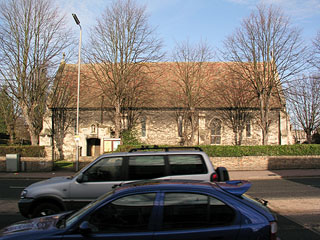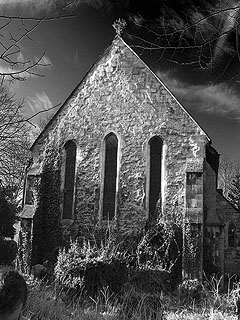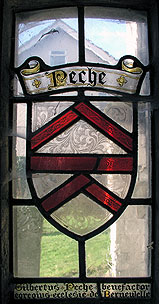 |
St Andrew's sits next to the dreadful Newmarket Road, choking on the car fumes. This is now one of the less salubrious bits of Cambridge, stuck between a megastore wasteland and the Four Lampposts Roundabout. It's also known as 'The Abbey Church' - which must be a reference to the fact that this area was the site of Barnwell Priory. This was an Augustinian house which started its life up near the Castle in 1092 and was quickly moved to this more spacious site near the river in 1112.
[Mark adds: this was given by the second Sheriff of Cambridge, who went by the splendid name of Pagan Peverel - and apparently said it was 'thirty years since my baptism and thirty years until I shall go to heaven, so I will have thirty canons to intercede for me' and gave the monks 'very true, precious relics set in gold and topaz which he had acquired on the expedition to Antioch' - I wonder what happened to those?... I may as well quote what Dugdale has to say about it in his 1692 Monasticon Anglicanum:
'Perceiving that the site on which their house stood was not sufficiently large for all the buildings needful to his canons, and was devoid of any spring of fresh water, Pagan Peveril besought King Henry to give him a certain site near Cambridge...from the midst of that site there bubbled forth springs of clear fresh water, called at that time in English Barnewell, the Children's Springs, because once a year on St John Baptist's Eve, boys and lads met there, and amused themselves in the English fashion with wrestling matches and other games and applauded each other in singing songs and playing musical instruments. Hence, by reason of the crowd that met and played there, a habit grew up that on the same day a crowd of buyers and sellers should meet in the same place to do business'.
Hmm, sounds distinctly pagan to me, probably another instance of the church adopting earlier sacred sites. ]
 |
It took until 1190 to finish the priory church of St Andrew, though whether this is due to magnificence or penury (or both) I haven't been able to find out. In 1211, King John granted a charter to the priory to hold a fair every Midsummer, and this assured the house's prosperity until 1506, when the city burgesses managed to wrest control of the fair from the monks. The fair still survives today, although its trading activities were gradually replaced by amusements in the latter half of the 19th century. The priory itself fell in the dissolution, of course. Of the extensive buildings the only remains are the present church (once a chapel on the south side of the site) and a claustral building (the nicely vaulted Cellarar's Checker which sits forlornly at the corner of Beche Road and Priory Road). The rest was taken away for use by the colleges and local gentry - the Cromwells took a gilded ceiling to Hinchingbrooke House, where it can still be seen. Most of the site was finally levelled in the early 19th century.
St Andrew the Less is a rather sad sight. I can understand keeping the church itself locked, given the character of the neighbourhood. To keep the churchyard locked seems unnecessary. I rattled the gate sadly, and looked unsuccessfully for another way in. I considered vaulting over the gate, but it would hardly have been worth it - the churchyard is little more than a grass verge on the southern side of the building, and I've seen more than enough privet and broken gravestones in my time. [When I called here with Ben, to take some pictures, we did climb the wall and found a wild, cat-haunted, unkempt area behind and to the east of the church which was strangely appealing. Over the low wall at the back of the church you can look down a steep drop into the carefully cultivated gardens of the terraced housing that now covers the site of the Priory. I wonder what Gilbertus Peche - see the picture of the porch window - would have thought of what happened to his spiritual insurance policy?...]
 |
The church itself is a tiny building - just a nave and a chancel - and although much of the building is 13th century, it had quite an aggressive going-over from the Victorians. The whole of the north side is rebuilt, and the windows on the south side are all obviously neo-Gothic. The south doorway is transitional, but the porch that shields it is from the 1920s and exceedingly boring. In the west wall there are some original lancet windows, and above them the bells hang in a little double-lancet at the apex of the wall. This would be rather nice except that they are now 'protected' by an ugly wire cage. St Andrew's is now in a united parish with Christchurch a few hundred yards to the west, and they only hold services here once a month.
I can understand why - this is (to be brutally honest) an ugly little church, while Christchurch is big and Victorian and possessed, I assume, of good heating. Still, it is sad to see a church so unloved, and I feel that one of the last fragments of Barnwell Priory deserves a better fate.
St Andrew's is kept locked, without keyholders.